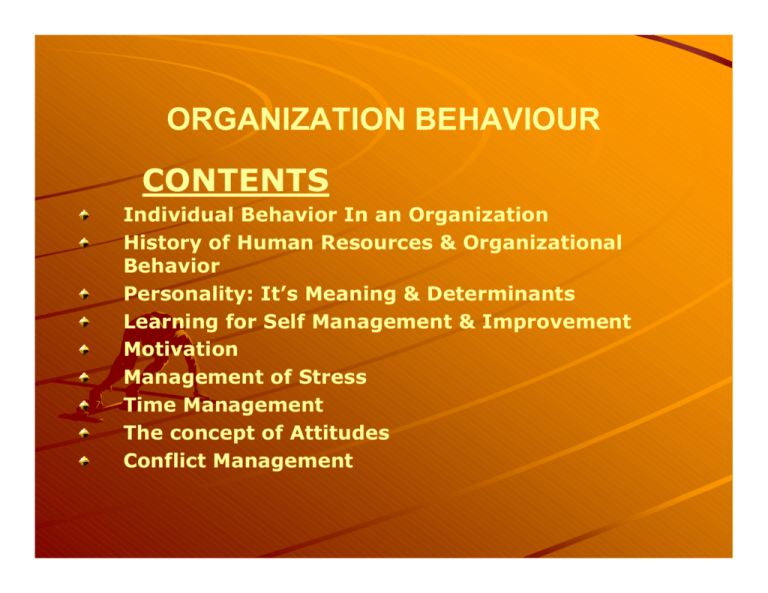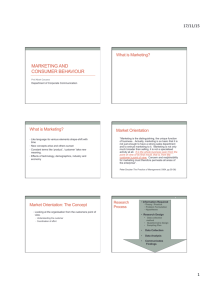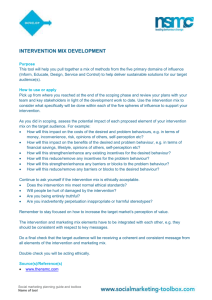Organizational Behavior: Individual Behavior & Values
advertisement

ORGANIZATION BEHAVIOUR CONTENTS Individual Behavior In an Organization History of Human Resources & Organizational Behavior Personality: It’s Meaning & Determinants Learning for Self Management & Improvement Motivation Management of Stress Time Management The concept of Attitudes Conflict Management CHAPTER 1 Individual Behaviour in an Organization Human Behavior has been believed to be the outcome of or response to certain external and internal forces called stimuli. Two views of how Human Behaviour occurs are discussed: a) The Traditional View b) The Input-Output System CHAPTER 1 Individual Behaviour in an Organization a) The traditional View- (SOB Model) Behaviour is the Response to a Stimulus. i) Situation comprising of stimulus and environment (what pervades inside and outside of the individual) ii) Organization occurs through physiological and cognitive means. iii) Behaviour emerges as patterns of action as an outcome. CHAPTER 1 Individual Behaviour in an Organization b) The Input-Output system Behaviourial scientist B J Kolasa viewed Behaviour from a “system” point of view which states that Output is the outcome of Input on which some action has taken place. Input + Processing--Æ Output Stimulus+ Internal/External processing--Æ Response CHAPTER 1 Individual Behaviour in an Organization Biographical features affecting Behaviour: a) Age b) Gender c) Length of Service d) Marital Status CHAPTER 1 Individual Behaviour in an Organization Biological Foundations of Behaviour: a) Heredity b) Biological Development – glands c) Nervous System d) Cognitive Process – Thinking, Problem Solving, Day dreaming & Artistic thinking CHAPTER 1 Individual Behaviour in an Organization Foundations of Individual Behavior An understanding of individual behavior begins with a review of major psychological contributions to OB. These contributions are subdivided into four concepts: a) Values b) Attitudes c) Perception d) Learning We are covering Values in this Chapter CHAPTER 1 Individual Behaviour in an Organization a) Values – Values represent basic convictions that “a specific mode of conduct or end-state of existence is personally or socially preferable to an opposite or converse mode of conduct or end-state of existence” Values highlight an individual’s idea as to what is right, good or desirable. Values system is the priority list of Values, in descending order, which the individual stands for. E.g. freedom, pleasure, self respect, honesty, obedience, equality, etc. CHAPTER 1 Individual Behaviour in an Organization Types of Values -Two approaches to developing Value typologies are covered as follows:a) Rokeach Value Survey (RVS) developed by Milton Rokeach b) Contemporary Work Cohorts developed by Stephen Robbins CHAPTER 1 Individual Behaviour in an Organization a) Rockeach Value Survey There are two sets of Values, each containing 18 items. The two sets are: i) Terminal Values ii) Instrumental Values CHAPTER 1 Individual Behaviour in an Organization i) Terminal Values: These are desirable end-states of existence and comprise of Goals that a person would like to achieve in his lifetime. ii) Instrumental Values: These are the modes of behaviors or means of achieving the Terminal Values. ( Refer to Exhibit 1-2 from course material for examples) CHAPTER 1 Individual Behaviour in an Organization b) Contemporary Work Cohorts Stephen Robbins classified Work Values into four groups based on the era – period of time in history- when they entered into work. Each group represents a Cohort or a Generation CHAPTER 1 Individual Behaviour in an Organization The four groups are: 1) Veterans - 1950s to early 60s 2) Boomers – 1965 to 1985 3) Xers – 1985 to 2000 4) Nexters – 2000 to present (Refer to Exhibit 1-3 of course material for more details) CHAPTER 1 Individual Behaviour in an Organization Values, Loyalty & Ethical Behavior Loyalty is dependent upon the Values the employees cherish. Level of Loyalty is a function of Ethical Behavior CHAPTER 1 Individual Behaviour in an Organization Values across Cultures Values across different Cultures are different and are impacted by five factors: 1) Power Distance 2) Individualism Vs Collectivism 3) Quantity of life Vs Quality of life 4) Uncertainty Avoidance 5) Long-term Vs Short-term orientation ( Refer to Exhibit 1-4 of course material for more details) CHAPTER 1 Individual Behavior in an Organization Summary • Human Beings are unique and so are their behaviors. • We need to study Human Behavior based on certain scientific theories and observations. • Behaviors and Motivation are significant indicators of individual effectiveness in organizations. • Individual Behaviors are shaped by many factors like age, gender, marital status, biographical characteristics, etc. • Higher mental processes like cognition, logical reasoning, etc. contribute significantly in understanding the patterns of human behavior.







